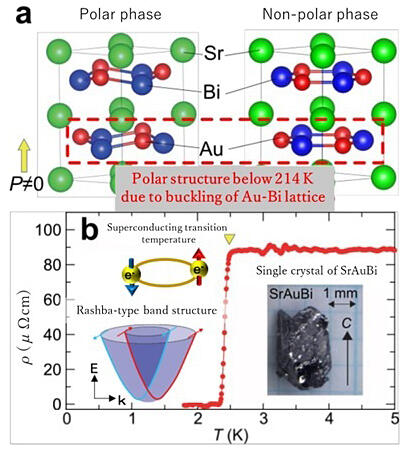A research group consisting of Lecturer Hidefumi Takahashi, Graduate Student Tomohiro Sasaki, and Professor Shintaro Ishiwata from the Graduate School of Engineering Science at Osaka University, in collaboration with Assistant Professor Akitoshi Nakano from the Graduate School of Science at Nagoya University and Assistant Professor Kazuto Akiba and Professor Tatsuo Kobayashi from the Graduate School of Environmental, Life, Natural Science and Technology at Okayama University successfully synthesized an extremely rare superconductor with a topological band structure, demonstrating a polar-nonpolar structural phase transition similar to a ferroelectric phase transition. For the first time globally, they have discovered that a topological semimetal composed of strontium (Sr), gold (Au), and bismuth (Bi) can exhibit both a polar-nonpolar structural phase transition (similar to the ferroelectric phase transition) and superconductivity.
Ishiwata stated, "The exploration of new superconductors often faces many failures, but it possesses the pure physics appeal leading to an understanding of the fundamental principles of nature. Additionally, it offers the fascination of witnessing the diversity and unpredictability inherent in nature." The results of this research were published in npj Quantum Materials.

Provided by Osaka University
In conventional s-wave superconductivity, as described by the BCS theory, phonon-mediated superconducting electron pairs (Cooper pairing) exhibiting space inversion symmetry are formed. Therefore, these symmetry-breaking polarities are generally incompatible with s-wave superconductivity. On the other hand, superconductivity achieved in materials with disrupted space inversion symmetry is expected to be unconventional. Specifically, in systems where space inversion symmetry is disrupted, the concept of superconducting electron pairing involving singlet-triplet mixing has been proposed.
In topological materials with nontrivial geometric properties in their band structures, the possibility of surface superconductivity arising from unique surface states has been suggested. Ongoing investigations into superconductivity in such materials are actively underway.
The research team successfully synthesized a single crystal of the semimetal SrAuBi and observed a polar-nonpolar structural phase transition at 214 K along with a superconducting transition at 2.4 K. This semimetal has a stacked structure made up of a triangular lattice consisting of Sr2+ and a honeycomb lattice consisting of Au-Bi. At temperatures below 214 K, the honeycomb lattice layer changes shape, resulting in a polar structure with disrupted space inversion symmetry. Therefore, SrAuBi is a very rare system that exhibits superconductivity despite its polar structure.
To investigate the superconducting properties of this material in detail, the team measured how the superconducting transition temperature changed when applying an external magnetic field in both in-plane and out-of-plane directions, reaching extremely low temperatures around 0.2 K. As a result, they discovered that the out-of-plane magnetic field achieves a superconducting critical field of 5 T, exceeding the Pauli limit expected for conventional superconductors. Additionally, through first-principles calculations, they observed the realization of Rashba-type spin splitting in the band structure near the Fermi level. This phenomenon results from the strong spin-orbit coupling and polar structure originating from the Bi p orbital, leading to the emergence of multiple Dirac points.
Furthermore, the crystal thickness dependence of the critical current differs from the bulk superconducting behavior, suggesting the presence of surface superconductivity. The surpassing of the Pauli limit by the critical magnetic field suggests the potential for superconductivity in the topological surface state and the Rashba-type band structure arising from strong spin-orbit coupling. SrAuBi is envisioned as a promising system demonstrating novel unconventional superconductivity.
The origin of superconductivity in this system is attributed to the electronic states of Bi and Au with strong spin-orbit coupling. This holds the potential for serving as a superconducting spintronics that exhibits novel magnetic field responses. It is also expected to achieve topological superconductivity arising from the polar structure and serve as a potential quantum computer device.
Journal Information
Publication: npj Quantum Materials
Title: Superconductivity in a ferroelectric-like topological semimetal SrAuBi
DOI: 10.1038/s41535-023-00612-4
This article has been translated by JST with permission from The Science News Ltd. (https://sci-news.co.jp/). Unauthorized reproduction of the article and photographs is prohibited.




